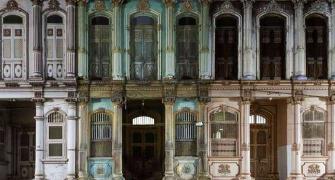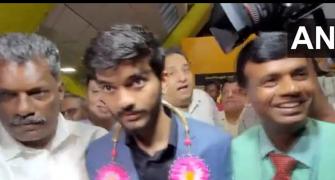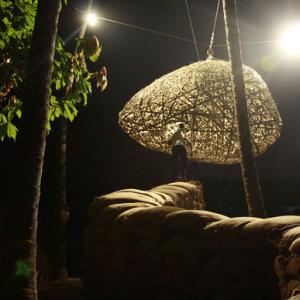Street art has emerged from its rebellious underground existence to a growing art genre in its own right.
Ritika Bhatia maps the Indian leg of the movement.

Murals, stencils, tags and larger-than-life splashes of colour are starting to pop ever so often across the capital's dreary urban landscape. In Azadpur Mandi, Asia's largest fruit and vegetable market, the Delhi Cold Storage building has become the latest canvas.
On the 60 feet high and 100 feet wide facade of the building, Miami-based artist Axel Void has painted a table with a kitchen knife, some fruit and vegetables illuminated by a single white candle. The work has the word "Zindagi" written in Devanagari across it: such is the mundaneness of life.
On the other side of the city, Rani Laxmibai of Jhansi adorns an archway-like wall in south Delhi's Lodhi Colony. The work, showing the queen with a sword in one hand and the reins of her horse in the other, her feisty gaze locked on the horizon, is one of the rare women-centric public art pieces in the capital. Made by Japanese-American street artist Lady Aiko, this mixture of styles in stencils and geometrical patterns gives it a very pop-art yet traditional feel.
In central Delhi, at Connaught Place, there are paste-ups of a hand, with its middle finger pointing outwards, marked with voter's ink, captioned "Mat do". This piece of work is stark, in aesthetics as well as in contrast to the two works at Azadpur and Lodhi Colony. It is the original rebellious street art and is the handwork of Daku, considered the country's foremost graffiti artist who "robs walls" and prefers keeping his identity hidden.
The first two were painted by artists participating in the street art festival organised by St+Art India Foundation, the second edition of the festival which has been going on in Delhi since February. From commissioned legal street art pieces to works of graffiti or "vandalism", street art is flourishing in the country like never before, claiming walls in tony residential colonies and rundown wholesale markets. Chennai's Conquer the Concrete, Street Art Project Pune and Rishikesh Street Art Festival are the other three big festivals that have already taken place this year. Kolkata and Bengaluru too have a strong graffiti culture.

At the St+Art headquarters in a fourth floor walk-up in Hauz Khas Village, I try to gather a sense of how street art in India has snowballed in recent past. The main organisers, Hanif Kureshi, Akshat Nauriyal and Arjun Bahl, are a swell bunch of guys in their late 20s or early 30s.
Kureshi was earlier involved in Khirki Extension, a street art festival in Khirki Village in 2012, considered the first organised event of the sort in the city. But with St+Art, they wanted to go bigger and paint the whole town. "We decided that this time we'll do it right, with legal permits, graffiti jams, international artists — the whole jig," says Bahl.
They went about obtaining permissions from the New Delhi Municipal Council (NDMC), Central Public Works Department, Delhi Police and other state agencies. After a few months of making the rounds of sarkari daftars, they identified Shahpurjat as an area ripe for a visual transformation and pitched a large mural of Mahatma Gandhi on the Delhi Police headquarters at ITO. "We were hoping nobody could say no to Gandhi, and it worked," chortles Nauriyal.
OP Mishra, former director of projects, NDMC, says that his team was on the lookout for artists to come forward and beautify the city when they were approached by the St+Art crew. "As long as it was non-political, non-religious art that hurt no sentiments, we were happy to give them walls and spaces," says Mishra, rattling off the now-familiar spiel of what constitutes "acceptable Indian culture".
While the St+art festival organisers had a resounding start last year, with successful editions in Delhi and Mumbai, the current Delhi edition has been stuck in limbo. CPWD hasn't cleared permissions for many buildings slated to be painted. "It'll be great if they had a process for public art and we won't be shunted across the city for permits everywhere," say the organisers ruefully. Already pressed for funds, they are being forced to waste precious little -- especially on keeping the lifts that the artists need to work with on large-scale murals, on standby at different locations.
Last year, Delhi's Lt. Governor Najeeb Jung has turned out to be their first administrative ally, as he helped them with the permissions and actively encouraged the festival. Interestingly, within the grounds of Jamia Millia University, where Jung was earlier Vice-Chancellor, there was recently a group of students who took sanitary pads with messages against rape and sexism, sticking them on trees and other empty spaces.
Lauded for their striking efforts against patriarchy and for starting a dialogue on the taboo associated with menstruation, they were eventually sent notices by the university authorities. Urban art's rise is also evident in the large number of such independent, socially-oriented projects across India. Socio-political graffiti and interventionist art always seem to incite the ire of the authorities, but that is exactly why it is needed.
The stencil stickers of Guesswho, the anonymous artist (or group of artists) that went viral when the Kochi-Muziris Biennale was on, was testimony to the power of the Internet as far as street art is concerned. Part of the popularity of Daku and Guesswho is the intrigue of their anonymity, and the universal appeal of their visual and typographical puns.
While India's most famous art biennale was basking in its own glory, Guesswho's critiques of the traditional art establishment bearing satirical texts such as "SOLD!", "Deeper than you think", or fictional superheroes protesting the clampdown on the Kiss of Love campaign were the artworks that went viral online. Needless to say, most of these were taken down within the week.
In the age of social media, cult figures like Banksy have introduced street art to a whole new generation and spawned copycats worldwide. That's also the reason the Google Cultural Institute has recently launched a street art project curated from around the world. St+art Foundation is representing its festival there.

While most of the street art festivals in India are community-funded, such as the ones held in Pune and Rishikesh, international cultural institutes have also contributed. Asian Paints donated paints and other raw material to the St+art Foundation as a part of its corporate social responsibility activities.
According to Samyukhta, spokesperson of Goethe-Institut Chennai, which curated the Conquer the Concrete initiative in the city, "Traditionally, street art is subversive, but here we wanted to take art out of the galleries and put it out on the street." The idea was to facilitate a collaboration between Chennai's traditional hoarding artists and Indian and German street artists. The Goethe-Institut plans to make it an annual affair.
When India Art Fair approached Daku to do a piece in January, his response was to repeatedly write the words "commissioned vandalism" on the street leading up to the fair. "The interesting thing is that while this piece is at the India Art Fair, it's not really inside," explains Daku. "Keh sakte hai ki dehleez pe hai (It's on the threshold). It's knocking on the art industry's door, telling them that hey, street art is here and here to stay." His pieces are intended to be open-ended, and with corporations vying to get a piece of the street art pie, it's easy to read into "commissioned vandalism" as a comment on street art worldwide.

This translocation from the streets to the institutions is symptomatic of a global trend of graffiti, once an anti-establishment exercise carried out in the sly, going mainstream. In India too, graffiti artists are now commissioned by brands, corporations, cafes, bars and cultural festival organisers.
"What I really love about street art is the purity of it – it is the rawest form of art, but also an industry that's gaining popularity," says Harsh Raman Singh Paul, a well-known designer and street artist. "I've got calls from brands such as Absolut and Adidas." For him, things become complicated when money comes in. So he is skeptical of as well as hopeful about the growing movement.
The consensus among artists seems to be that the graffiti scene in the country still has to evolve. The best thing about festivals for Anpu Varkey, one of the few female artists on the beat and certainly the most prolific among them, is "the visual dialogue with the city and its people" that street art facilitates.
"Consuming graffiti online is the new fad in the country but I am more interested in reaching a larger audience through street art, people who are seeing it live on their walls, not their Facebook walls," she says. And participating for the first time in an event of this kind, Daku says, "For St+Art, I'm planning to do a piece that will be my take on the Swachh Bharat Abhiyan." It should be up some time next week, so keep an eye out for some commissioned vandalism, will you?










